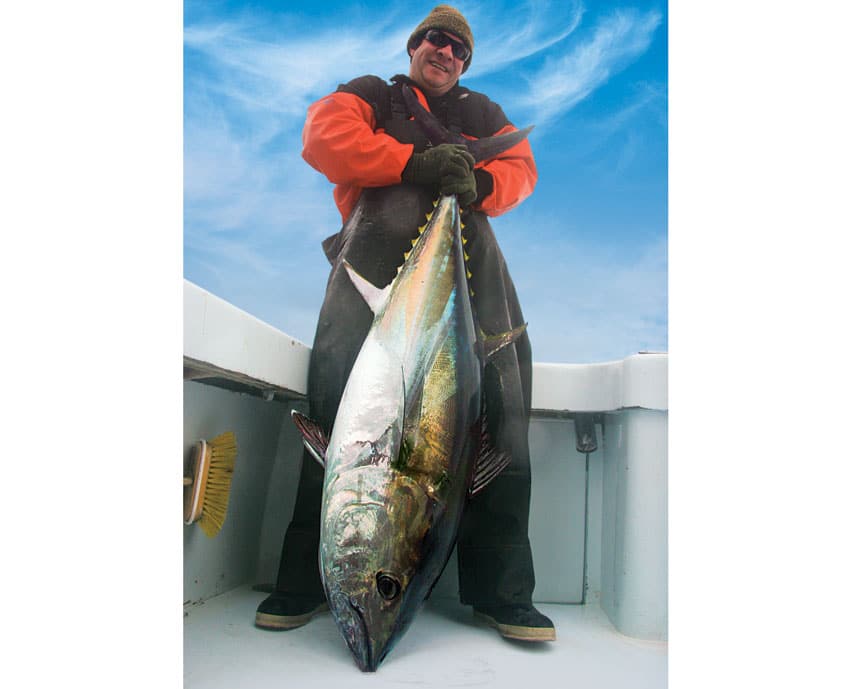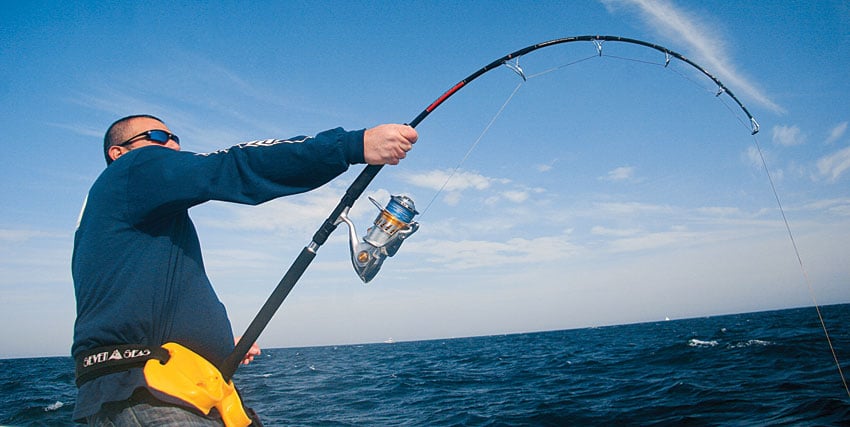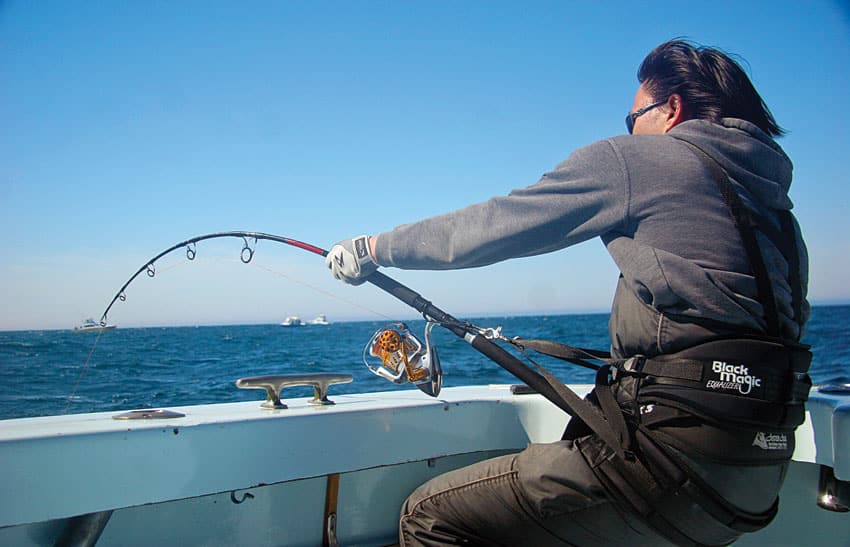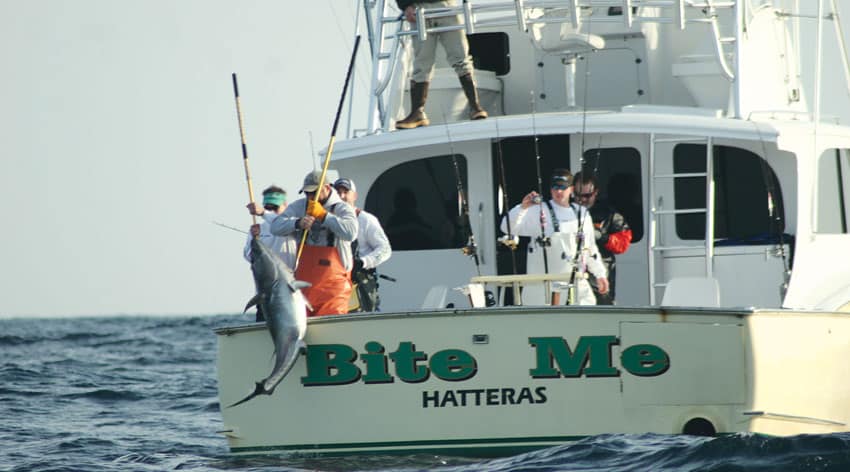
Thirty-knot winds howled through the outriggers at dockside, and hot coffee turned cold quickly at 4:30 a.m. on that late February morning. “Typical Hatteras seas, fellas — six- to eight-foot northeast and pretty nasty, but let’s give it a shot,” said Capt. Dan Rooks of the 50-foot custom Buddy Cannaday Tuna Duck. Sea spray cascaded over the bow as we plowed through Hatteras Inlet, North Carolina, headed for the bluefin grounds 30 miles away — Diamond Shoals tower, where we set out trolling lines. Things warmed up fast. Rooks shouted, “I’m markin’ ’em; get ready!” After only a few minutes, the port-stern bent-butt 130-class setup began screaming as my buddy Mickey Melchiondo took the fighting chair to put in some serious work.
“Drop the jigs now!” Rooks commanded. Jigging gurus Sami Ghandour and Paul Chua deployed flutter jigs over the side, snapped the bails shut and made one swooping jig motion each, and the two rods bent down hard. The three-ring circus was on! In 10 minutes we fought, tagged and released three bluefin tuna of 100 to 130 pounds, but we weren’t into the fabled freight trains we’d come looking for — yet.
My Blue Heaven
Since the mid-’90s, the Outer Banks has held a wintertime bluefin tuna bite close enough to shore for surf-casters to witness tuna crashing striped bass schools, but they can be found more consistently 10 to 30 miles out. The schools of large bluefin began to modify their migratory pattern to hug the Carolina coast along the Diamond Shoals roughly 15 years ago, and these aren’t schoolies either, but portly wintertime bluefin up to 400 pounds, with occasional true giants of 700-plus pounds. This Hatteras fishery draws anglers by the thousands to sample the pain and punishment the bluefin can dish out, but as the years have gone by, contemporary tackle and technique have shifted from 130-pound outfits to lighter composite setups that lessen the knuckle-busting battles and ease the stress on both angler and fish.
The New Style
Historically, ballyhoo trolled with Ilander lures on heavy gear has been the standard practice in North Carolina for hooking up with the Volkswagen-size beasts, but I am a convinced man on the advantages of new-style composite-rod jigging. Ghandour and Chua of Saltywater Tackle in Brooklyn, New York, each standing not much over 5-foot-6, put the boots to 250-pound bluefin like school was in session, using miniature composite rods and beefy spinning reels. On our trip, Ghandour walloped an 80-incher in just under 15 minutes, and that kind of efficiency is desirable when you are releasing many of these large bluefins in accordance with federal regulations. The less time you fight them, the better chance they have to survive. You would think a steroid setup of a 130-pound bent-butt rod would outduel a big bluefin better than a dinky 5-foot spinning rod, but my eyes saw differently. Composite rods and large spinning reels matched with braided line offer sensitivity to allow jigs to flutter freely while maintaining stalwart hook-setting power, and this gear withstands the rigors of pumping in large tuna quickly. Jigging is a lot of work, but it’s a clean-up method to get solid strikes, many times with multiple hookups for all involved.
“We always rely on trolling to locate schools and identify the depth they are staging at,” said Rooks, “but when I take out seasoned guys who know how to jig, we stop on the fish, and they can really reel ’em in.” Ghandour uses Japanese-made Medusa rods matched with Shimano Stella 20000 heavy-duty reels. “I tighten down the drags to 30 or 35 pounds of pressure so I can beat them quickly,” said Ghandour. That might be fine for the 100- to 250-pounders, but Chua hooked up with four monster fish on our second day out, battling each for at least 30 minutes before the 200-pound leader snapped as the leviathan made a strong surge. More sensible drag sets would be in the 25- to 30-pound range to ensure that large bluefin don’t break the bank, but it’s a feel-it-out, split-second-decision game to know when to loosen the drag to prevent break-offs with larger fish.
Pump and Reel
Hooking a tuna is one thing, but outmuscling a tuna is an art form, and many anglers fight themselves out of the game without proper technique. The pump-and-reel method consists of hooking the fish, letting it do its initial run and then pumping the short rod up while reeling down, all the time turning the fish’s head upward to the surface to cajole it to the boat. When the tuna runs forward, the captain puts the boat in gear to get ahead of it, but Rooks notes that when that happens: “The tuna gets more oxygen through his gills, which invigorates the fish. It’s of paramount importance to keep the fish at the stern and keep him on an up-and-down approach. That’s the key to besting big bluefin before they best you.” An old saying goes, “When you rest, he rests,” so when you are lollygagging to rest your muscles, that tuna is doing the same. Always keep the pressure on, and direct the fish where you want it to go — otherwise, you could literally be there for a half-day or longer as the fish rests and regains energy when you are too weak to reel. This is a heavyweight fight, make no bones about it, and you have to be physically and mentally prepared for it. Don’t go into a bluefin trip out of shape and weak of mind.
For the Record
The first day’s score card was 6 for 9 on bluefins to 130 pounds, but the second day’s fish had some shoulders to them. Ghandour and I landed two fish, 270 and 250 pounds, and Chua snapped off at least four more that were too big to stop. How big is too big in Hatteras? A week after our trip, a new state-record bluefin of 805 pounds was muscled in, and I’m betting that fish had some role in stealing Chua’s jigs!
Outer Banks Tuna
Bluefin jigging and popping has been standard practice in the Northeast for some time but has just caught on in the Outer Banks, with some ferocity.
Rods: Trolling gear has always been bent-butt rods matched with 130-class reels, but new composite jigging rods are taking over fast. Try a Shimano Trevala TFC58H, Penn Torque TJ8013C58 or MC-Works 5-foot Ultimate Monster SD538XX.
Reels: Trolling reels 80- to 130-class, conventional 20-pound-class reels or Shimano Stella 20000 spinning reels for jigging.
Lines: Braided line reigns supreme. Use a 100-pound braid running line with a wind-on leader system.
Lures: Trolled ballyhoo, Shimano or Williamson butterfly jigs, Shout Shab Shab jig or Yo-Zuri Hydro poppers.
The Outer Banks bluefin tuna fishery really opened up only in the mid-’90s and has had some up and down years since then, but Diamond Shoals consistently holds fish close to shore, with easy access out of Hatteras, Morehead City and other Outer Banks ports. Hatteras seas are unpredictable and volatile, and you really need to schedule a three-day window to ensure some fishable time, because seas can range from one to 14 feet and back in the course of a day.
What: Medium-class to giant bluefin tuna 100 to 900 pounds.
When: December through March, with federal regulations constantly changing. Call 888-USA-TUNA (888-872-8862).
_
Where:_ Diamond Shoals and surrounding areas out of Hatteras.
Who: Capt. Dan Rooks
Tuna Duck
252-216-6160
www.tunaduck.com
A Note on Conservation and Handling
The bluefin fishery off the Outer Banks has remained strong, but giant bluefin tuna stocks are in trouble worldwide. The cause of their demise has been debated to death, but all arguments seem to point to the flouting of laws by the Mediterranean commercial fleets as a major factor. As U.S. recreational anglers play catch-and-release with bluefins, it is important that we beat fish as fast as possible and extract the hook with the tuna in the water. If you have to bring a large tuna on board to measure it for the icebox, Tuna Duck mate Mike Edwards has the method: “Slip the tuna through the transom door as carefully as possible with a gaff in the lower jaw; insert a running saltwater hose in its mouth to keep the oxygen moving over the gills; measure it; and quickly determine if it is to be kept or released. If it’s a release, slip it right back through the transom door headfirst.” Everybody loves a money shot, especially of their first large tuna, so if you do take photos for a release, either lie down next to the fish or hold it by the tail, but do not lift it up vertically. The tuna should not be in the boat for more than 45 seconds if you are releasing it, so plan accordingly and move fast to ensure the survival of the magnificent fish. For information on tuna tagging and conservation efforts, contact Tag-A-Giant: 631-539-0624; www.tagagiant.org.



















